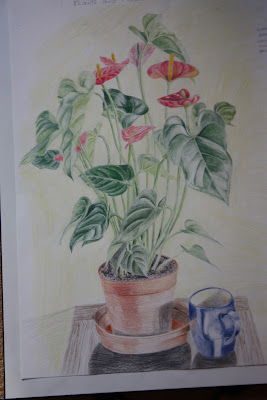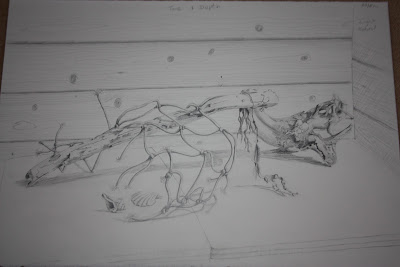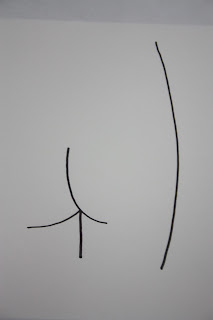I have been asked to find two artists that whose work shows a tight and detailed style of drawing and one whose work is of a loose and freer style, so I have chosen Durer and Picasso. The reason why I chose these two artists to discuss is that both of them had vivid imaginations and were the product of their times and whatever era they were in they would still have achieved great work due to their extraordinary talent which was evident at a young age.
Albrecht Durer a Brief History
Self Portrait with gloves 1498
http://www.bridgemaneducation.com/Search.aspx
Albrecht Durer was born on the 21st May 1471 and was the 3rd child of Albrecht Durer a goldsmith in Nurenburg. After a few years in school he started to learn the basics of goldsmithing and drawing from his father and at the age of 15yrs his obvious talent for drawing led him to be apprenticed to Michael Wolgemut the leading artist in Nurenburg at the time.
His apprenticeship complete he took a gap year when he travelled and learned skills from other artists. At the age of 23yrs he was married to Agnes Frey and this was a childless union.
In 1494 to 1495 he travelled to Venice alone to study and this was to greatly influence his work. On his return to Nurenburg he opened a workshop and in the begining his woodcuts were his best works and were mostly of a religous theme. He trained himself to use the burin to make engravings and produced numerous relious works and his notariety spread throughout the artistic areas in Europe. In 1495 He began to seriously study mathematics and the theory of art which he applied to his work and experimented with proportion to produce a better harmony and perspective. His mathematical proportions were influenced by his experiences in Italy and from antiquity.
During the early 1500's he continued his work with proportion and produced an acclaimed engraving of Adam and Eve.
Adam and Eve 1504 Engraving
http://www.bridgemaneducation.com/Search.aspx
He continuously studied and devoted his time to mathematical form and drew upon his geometry to achieve his aims. By 1523 he had completed a manuscript on the Treatise on Proportion. He continued his studies until his death on April the 6th 1528 and his legacy of producing carefully proportions figures worked out by a mathematical formular became widely influencial among subsequent artists.
http://www.encyclopedia.com/topic/Albrecht_Durer.aspx
Although Durer was obscessed with his mathematical formulae his work wasn't rigid or defined he had a vivid imagination that wasn't reliant on copying from nature or other works. He embraced the gothic style and and EH Gombrich wrote that he proved himself a master of the fantastic and the visionary, a true heir of those Gothic artists.
EH Gobrich The Story of Art
Phaidon Press Limited1995. The fact that a lot of his work was engraving and woodcut this technique had to be well drawn and tight in style and Durer strove for perfection. Gombrich also wrote that 'Durer had patience which enabled him to draw sketches which made him a born engraver, who never tired of adding detail upon detail to build up a true little world with the compass of his copper plate.' I think that the Nativity explains this very well it is an incredibly piece of work.
The Nativity Engraving 1504
http://www.bridgemaneducation.com/Search.aspx
I think that his whole approach to his work was his detail whether it was a fantasy piece or a work copied from nature.
The Revelation of St John the Divine or the Apocalypse
http://www.bridgemaneducation.com/Search.aspx
It is difficult to know when to stop downloading his work as I am so enthralled with them but I have to download his drawing of a human skull which looks so anatomically correct that he has observed the optic nerve aperture in the back of the lt eye socket and has the correct number of teeth albiet some are missing.
Study of a human skull 1521 (pen and ink and chalk on paper)
http://www.bridgemaneducation.com/Search.aspx
Pablo Ruiz Picasso a Brief History
Pablo was born in Malaga on 25th Oct 1881 and was named the lengthy Pablo Diego Jose Franisco de Paula Juan Nempomuceno Maria de los Remedios Cipriano de la Santisime Trinidad Ruiz y Picasso. He is one of the most famous artists of the 20th Century and his work has influenced architecture, fashion, advertising and even has a car named after him. He is chiefly known for his involvement with the development of the Cubism Movement.
He was the first child of Don Jose Fuiz y Blasco and Maria Picasso y Lopez. His father was a professor of art at the School of Crafts and when Pablo was 7yrs old he received formal training in art from his father. By the time he was 13yrs his father is said to have felt that his skills had been surpassed by his son.
In 1895 Picasso was deeply affected by the death of his 7yr old sister of diptheria and the family moved to Barcelona. Here Pablo was accepted into its School of Fine Art.
At the age of sixteen he set off to Madrid to study at the Royal Academy of Fernando but he quit soon after his enrollment.
In 1900 Picasso made his first trip to Paris then the art captial of Europe where he met Max Jacob a journalist whom with he shared accomodation. These were hard times and much of Picasso's work was burnt to keep them warm.
http://en.wikipedia.org/wiki/Pablo_Picasso
Moving between Spain and France he eventually settled in Paris 1904 where he experimented with different styles. In 1907 Picasso produced Les Demoiselles d'AvignonI a totally new and original style. This can be viewed on the following website.
http://www.moma.org/collection/object.php?object_id=79766 Picasso worked very closely with Georges Braque in the development of Cubism.
http://www.bbc.co.uk/history/historic_figures/picasso_pablo.shtml
In 1918 Pablo married Olga Khohlova a ballerina. They had child one called Paulo. Picasso and Khohlova ended in separation due to Picasso's infidelity and they remained legally married until Olga's death in 1955.
Picasso had many mistress during his life and he was married twice and had four children by three women.
Picasso's painting career was divided into periods testament to his ever evolving search for new styles of painting. 1901 -1904 was his blue period which was sombre and an autere expression of his work. This style was said to be influenced by the death of his friend Carlos Casagemas. His Rose Period followed on until 1906 and this was a more uplifting style with the use of pinks oranges and warmer colours and a change of mood. Many more styles followed such as the African Period, Analytic Cubism, and Surrealism.
Pablo died whilst entertaining friends with his second wife Jaqueline Roque on 8th April 1773 in Mougins.
Pablo Picasso's drawings are still very popular today and make statements on may peoples walls in the form of prints. I particularly like his line drawings which are so simple but he still captures the essence of his subject. I have copied a few and I will put in the web link so that the original can be also viewed.
My attempt to copy the Dog by Picasso original copy can be viewed on
http://www.allposters.co.uk/-st/Sketches-Studies-Drawings-Picasso-Posters_c96879_.htm
My attempt to copy La Femme by Picasso from the web link
http://www.allposters.co.uk/-st/Sketches-Studies-Drawings-Picasso-Posters_c96879_.htm
My attempt of a copy of the Owl by Picasso link below
http://www.allposters.co.uk/-st/Sketches-Studies-Drawings-Picasso-Posters_c96879_.htm
Although these particular drawings are very simplistic he produced drawings of immense style and complexity I particularly like the pencil on paper drawing of the Matador Luis Miguel Dominguin.
http://www.abcgallery.com/P/picasso/picasso73.html
Picasso was born in a time that allowed the pursuit of modernity and Durer confined to the aspirations of the Church and of the post medievel period and yet he allowed his imagination to flourish and impact on his work. So I think that their individual talents stood out in their own eras, their styles as different as the times they were bought up in.

















































